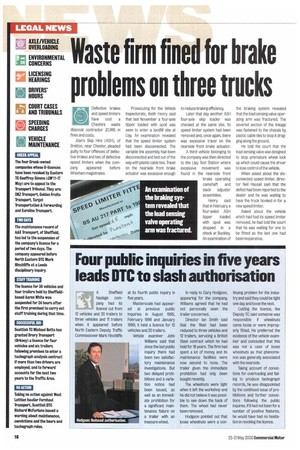Four public inquiries in five years leads DTC to slash authorisation
Page 18

If you've noticed an error in this article please click here to report it so we can fix it.
A Sheffield haulage company had its licence cut from 12 vehicles and 20 trailers to hree vehicles and 11 trailers when it appeared before North Eastern Deputy Traffic Commissioner Mark Hinchliffe at its fourth public inquiry in five years.
Masterscale had appeared at previous public inquiries in August 1995, February 1998 and January 1999; it held a licence for 12 vehicles and 20 trailers.
Vehicle examiner John Williams said that since the last public inquiry there had been two satisfactory maintenance investigations. But two delayed prohibitions and a variation notice had been issued, as well as an immediate prohibition for a significant maintenance failure on a trailer with an insecure wheel. In reply to Gary Hodgson, appearing for the company, Williams agreed that he had not personally seen the trailer concerned.
Director Ian Smith said that the fleet had been reduced to three vehicles and 12 trailers, servicing a British Steel contract which he had held for 18 years. The firm had spent a lot of money and its maintenance facilities were now second to none. The trailer given the immediate prohibition had only been bought recently.
The wheelnuts were tight when it left the workshop and he did not believe it was possible to see down the back of them. The wheel had never been removed.
Hodgson pointed out that loose wheelnuts were a con
tinuing problem for the industry and said they could be tight one day and loose the next.
Cutting the licence, the Deputy TC said someone was responsible if wheelnuts came loose or were improperly fitted. He preferred the evidence of the vehicle examiner and concluded that this was not a case of loose wheelnuts as that phenomenon was generally associated with the nearside.
Taking account of convictions for overloading and failing to produce tachograph records, he was disappointed by the continued issue of prohibitions and further convictions following the public inquires. If it had not been for a number of positive features, he would have had no hesitation in revoking the ricence.
















































































































